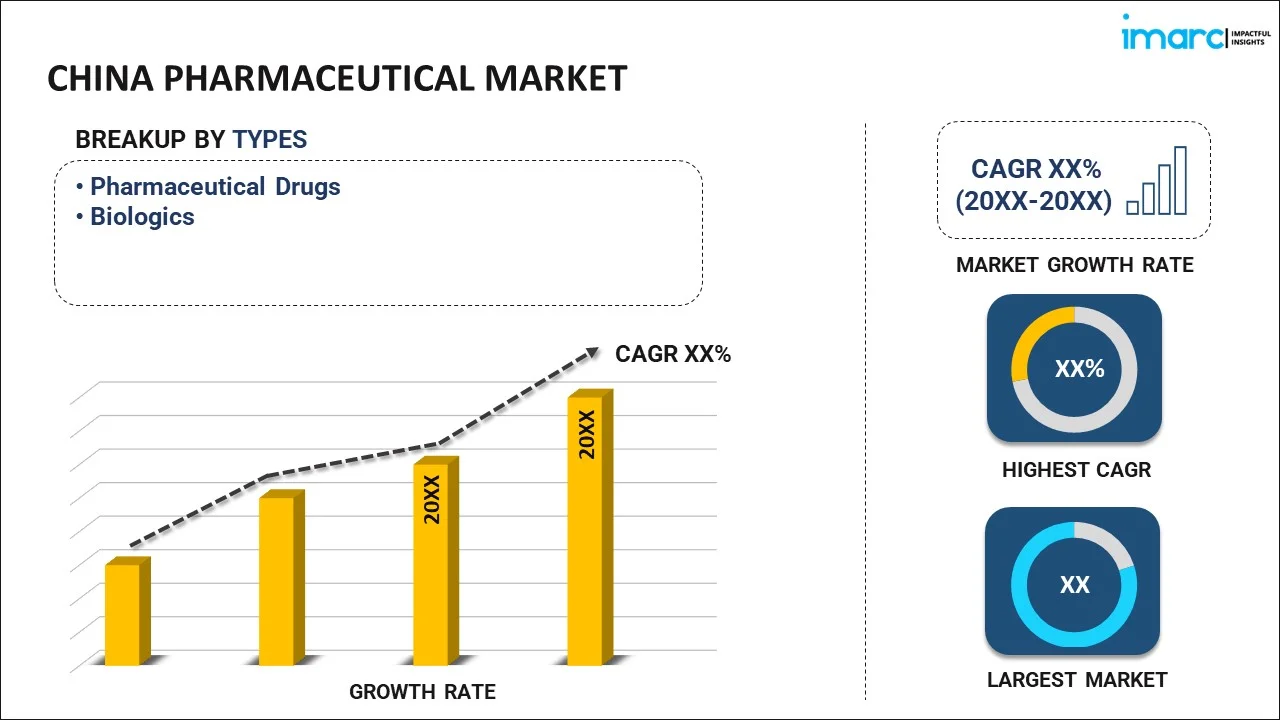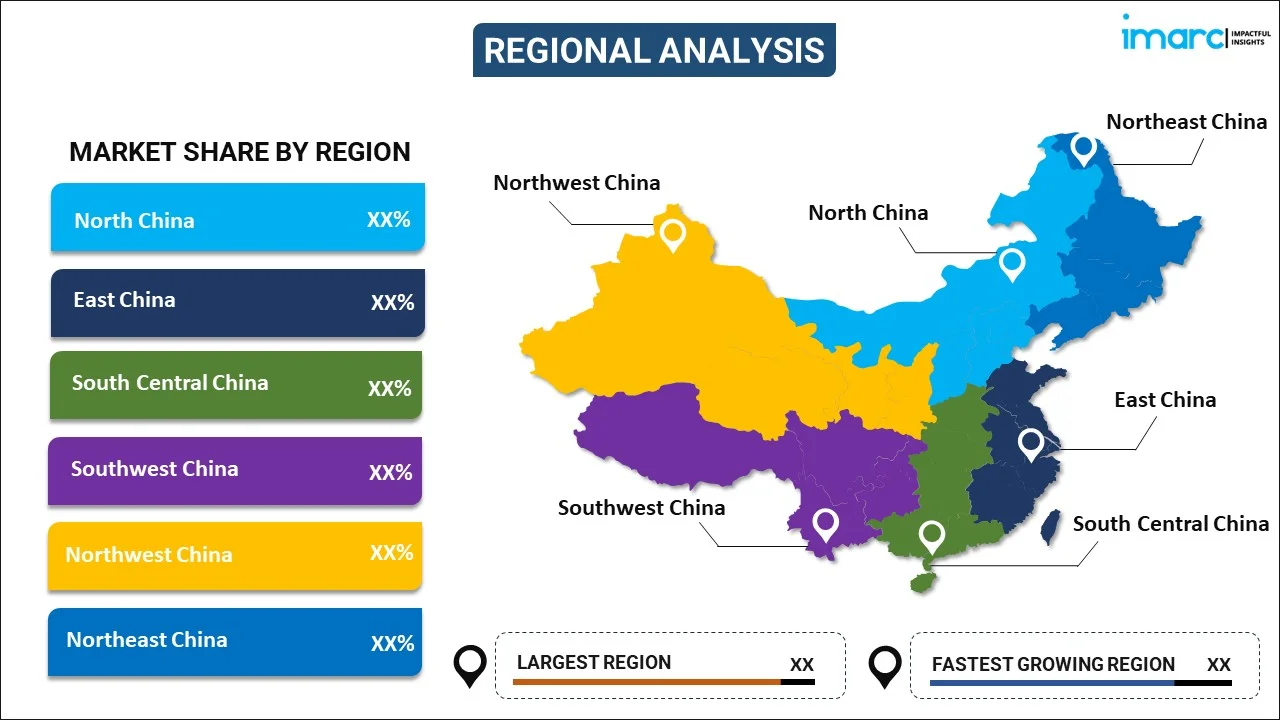
China Pharmaceutical Market Report by Type (Pharmaceutical Drugs, Biologics), Nature (Organic, Conventional), and Region 2025-2033
China Pharmaceutical Market Overview:
The China pharmaceutical market size reached USD 306.5 Billion in 2024. Looking forward, IMARC Group expects the market to reach USD 573.0 Billion by 2033, exhibiting a growth rate (CAGR) of 7.20% during 2025-2033. The market is driven by numerous factors, which include the rising geriatric population, increasing number of healthcare facilities like hospitals and clinics, prevalence of chronic diseases such as diabetes, arthritis, and cardiovascular issues. China has the world’s second-biggest pharmaceutical market.
|
Report Attribute
|
Key Statistics
|
|---|---|
|
Base Year
|
2024
|
|
Forecast Years
|
2025-2033
|
|
Historical Years
|
2019-2024
|
|
Market Size in 2024
|
USD 306.5 Billion |
|
Market Forecast in 2033
|
USD 573.0 Billion |
| Market Growth Rate 2025-2033 | 7.20% |
China Pharmaceutical Market Trends:
Rising Geriatric Population
The growing demand for pharmaceutical products among the geriatric population, as they are more prone to chronic diseases, is influencing the market positively. Elderly individuals are more vulnerable to conditions like diabetes, heart problems, and cancer as they get older. This demographic trend in China creates a substantial and growing market for pharmaceutical products tailored for managing and treating these chronic conditions. In addition, the market is expanding as a result of increasing awareness among individuals about the importance of early diagnosis, treatment, and management of chronic illnesses. Furthermore, pharmaceutical companies are putting more and more effort into creating drugs that are specially designed to meet the needs of elderly individuals. These medications include formulations that are designed to be easier to administer, have reduced side effects, and are more effective in managing age-related conditions. Companies are also focusing on producing more cost-effective pharmaceutical products to make them accessible to a larger elderly population in China. The China pharmaceutical market size 2024 reflected these shifting demographics and their impact on demand.
Increasing Number of Healthcare Facilities
As per CEIC, the number of hospitals in China was reported to be 39,000.000 units in 2023, an increase compared to 2022. The rising utilization of pharmaceutical products in hospitals, clinics, surgical centers, and nursing homes is bolstering the market growth. These facilities have huge patient influxes that are suffering from a wide range of disorders. Healthcare providers are prescribing various drugs that are beneficial in their healing process. Furthermore, governing authorities in China are concentrating on enhancing healthcare facilities by financing the purchase of advanced machinery and medical equipment. They are also focusing on providing numerous tax breaks, financial incentives, and support for biotech startups and innovation hubs, in addition to granting various product approvals. This modernization drive supports the growth of pharmaceutical sector in China as public and private investments continue to rise.
Expanding Global Reach of Chinese Pharma
Chinese pharmaceutical companies are making steady progress in building an international footprint. Driven by years of investment in generics and biosimilars, firms are now entering markets across Europe, Southeast Asia, and Latin America. Licensing deals, overseas acquisitions, and strategic alliances have helped them gain regulatory approvals faster, especially from the FDA and EMA. The push isn’t just from state-owned giants; private firms are also targeting oncology, autoimmune, and metabolic diseases for export. As domestic growth stabilizes, these companies are looking outward, not just for revenue but also for credibility. Their presence in international conferences, clinical trial networks, and innovation pipelines suggests that the Chinese pharmaceutical market is no longer content with a domestic focus.
Rise of E-Commerce and Digital Drug Sales
Online pharmacies and healthcare platforms are changing how medicine is bought and delivered in China. With platforms like JD Health and Alibaba Health capturing millions of users, digital sales are outpacing traditional retail in speed and accessibility. Prescriptions can be uploaded via mobile apps, followed by direct-to-door delivery, often in a matter of hours. Telemedicine integrations are also making it easier for chronic disease patients to refill prescriptions without stepping into a clinic. Regulatory support, especially during and after COVID, accelerated this shift. The result is a fast-growing segment where digital convenience meets healthcare access, and pharma companies are now tailoring launch strategies with this channel in mind. This surge has added momentum to the China pharmacy market, especially among younger, tech-savvy consumers.
AI Reshaping Drug Discovery and Development
Artificial intelligence is quietly but steadily becoming a tool in China’s pharmaceutical R&D. From protein structure prediction to compound screening and trial design, AI is speeding up early-stage development. Companies like XtalPi and Insilico Medicine are using machine learning models to generate new molecular candidates, some of which have already reached clinical phases. Government policy is encouraging this integration through grants and tech-focused industrial parks. Domestic pharma firms are partnering with AI startups to reduce time and cost in preclinical stages, especially in cancer and neurological drug pipelines. The impact is still in its early stages, but it's already shifting how companies plan their research cycles. These efforts are also expected to boost the China pharmaceutical market size 2025 significantly, with accelerated innovation pipelines.
Biologics Gaining Traction in Domestic Portfolios
Biologics have emerged as a key area of interest for Chinese pharmaceutical firms, particularly in therapeutic areas like oncology, immunology, and rare diseases. Companies are expanding biologics manufacturing capabilities, including monoclonal antibodies and gene therapies. With rising demand for precision medicine and targeted therapies, biologics are seen as a critical part of future growth strategies. Government initiatives supporting high-end biopharma production are giving this area a lift. As new biologics pipelines mature, the China biologics market is expected to see substantial growth in the coming years.
China Pharmaceutical Market Segmentation:
IMARC Group provides an analysis of the key trends in each segment of the market, along with forecasts at the country level for 2025-2033. Our report has categorized the market based on type and nature.
Type Insights:

To get more information on this market, Request Sample
- Pharmaceutical Drugs
- Cardiovascular Drugs
- Dermatology Drugs
- Gastrointestinal Drugs
- Genito-Urinary Drugs
- Hematology Drugs
- Anti-Infective Drugs
- Metabolic Disorder Drugs
- Musculoskeletal Disorder Drugs
- Central Nervous System Drugs
- Oncology Drugs
- Ophthalmology Drugs
- Respiratory Diseases Drugs
- Biologics
- Monoclonal Antibodies (MAbS)
- Therapeutic Proteins
- Vaccines
The report has provided a detailed breakup and analysis of the market based on the type. This includes pharmaceutical drugs (cardiovascular drugs , dermatology drugs, gastrointestinal drugs, genito-urinary drugs, hematology drugs, anti-infective drugs, metabolic disorder drugs, musculoskeletal disorder drugs, central nervous system drugs, oncology drugs, ophthalmology drugs, and respiratory diseases drugs) and biologics (monoclonal antibodies (MAbS), therapeutic proteins, and vaccines).
Nature Insights:
- Organic
- Conventional
A detailed breakup and analysis of the market based on the nature have also been provided in the report. This includes organic and conventional.
Region Insights:

- North China
- East China
- South Central China
- Southwest China
- Northwest China
- Northeast China
The report has also provided a comprehensive analysis of all the major regional markets, which include North China, East China, South Central China, Southwest China, Northwest China, and Northeast China.
Top Pharma Companies in China:
The market research report has also provided a comprehensive analysis of the competitive landscape. Competitive analysis such as market structure, key player positioning, top winning strategies, competitive dashboard, and company evaluation quadrant has been covered in the report. Also, detailed profiles of all major companies have been provided.
China Pharmaceutical Market News:
- 01 August 2025: Ascentage Pharma announced plans to join the Evercore China Biotech Summit in Shanghai from August 19–21, 2025. The company’s management is set to take part in a fireside chat led by Evercore ISI Research and hold one-on-one meetings with investors. Interested parties can schedule meetings through their Evercore contacts.
- 28 July 2025: Neuco United and Fosun Pharma signed an exclusive licensing deal for AR1001, an Alzheimer's therapy, in Greater China. Developed by AriBio, AR1001 is in Phase III trials across multiple countries, including China. The partnership aims to leverage Fosun’s manufacturing and commercial strengths to bring the treatment to Chinese patients. Neuco previously secured rights to AR1001 and has been co-developing it with AriBio since early 2024.
- 20 March 2024: Sinopharm signed a strategic cooperation agreement with Fresenius Kabi (China) Co Ltd. This aims to further consolidate and expand cooperation in areas like pharmaceutical sales, warehousing, distribution, healthcare, and medical care and wellness, with the goal of bringing better products and services to the Chinese people.
- 30 October 2023: Jiangsu Hengrui Pharmaceuticals Co. Ltd. (Hengrui) collaborated with Merck, a leading science and technology company. The partnership includes an exclusive license worldwide to develop, manufacture, and commercialize Hengrui’s next-generation potent and selective PARP1 (poly (ADP-ribose) polymerase 1) trapping inhibitor HRS-1167. The agreement also includes an option for an exclusive license worldwide to develop, manufacture, and commercialize Hengrui’s Claudin-18.2 antibody-drug conjugate (ADC) SHR-A1904.
China Pharmaceutical Market Report Coverage:
| Report Features | Details |
|---|---|
| Base Year of the Analysis | 2024 |
| Historical Period | 2019-2024 |
| Forecast Period | 2025-2033 |
| Units | Billion USD |
| Scope of the Report | Exploration of Historical Trends and Market Outlook, Industry Catalysts and Challenges, Segment-Wise Historical and Future Market Assessment:
|
| Types Covered |
|
| Natures Covered | Organic, Conventional |
| Regions Covered | North China, East China, South Central China, Southwest China, Northwest China, Northeast China |
| Customization Scope | 10% Free Customization |
| Post-Sale Analyst Support | 10-12 Weeks |
| Delivery Format | PDF and Excel through Email (We can also provide the editable version of the report in PPT/Word format on special request) |
Key Benefits for Stakeholders:
- IMARC’s industry report offers a comprehensive quantitative analysis of various market segments, historical and current market trends, market forecasts, and dynamics of the China pharmaceutical market from 2019-2033.
- The research report provides the latest information on the market drivers, challenges, and opportunities in the China pharmaceutical market.
- Porter's five forces analysis assist stakeholders in assessing the impact of new entrants, competitive rivalry, supplier power, buyer power, and the threat of substitution. It helps stakeholders to analyze the level of competition within the China pharmaceutical industry and its attractiveness.
- Competitive landscape allows stakeholders to understand their competitive environment and provides an insight into the current positions of key players in the market.
Key Questions Answered in This Report
The pharmaceutical market in China reached USD 306.5 Billion in 2024.
The China pharmaceutical market is projected to exhibit a CAGR of 7.20% during 2025-2033, reaching USD 573.0 Billion by 2033.
Rising healthcare demand, aging population, supportive government policies, local innovation, increasing urban incomes, digital health adoption, and expanding insurance coverage are driving China's pharmaceutical market. Foreign investment and regulatory reforms are improving market access, while generics and biotech sectors gain momentum due to cost pressures and rising chronic disease prevalence.
Need more help?
- Speak to our experienced analysts for insights on the current market scenarios.
- Include additional segments and countries to customize the report as per your requirement.
- Gain an unparalleled competitive advantage in your domain by understanding how to utilize the report and positively impacting your operations and revenue.
- For further assistance, please connect with our analysts.
 Request Customization
Request Customization
 Speak to an Analyst
Speak to an Analyst
 Request Brochure
Request Brochure
 Inquire Before Buying
Inquire Before Buying




.webp)




.webp)












